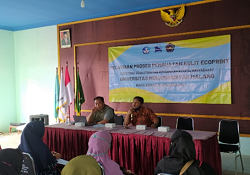Penerapan Teknologi Pewarnaan Ecoprinting Kulit Kambing Samak Krom pada Usaha Kecil Kerajinan Produk Barang Kulit di Desa Bululawang Application of Leather Ecoprinting Coloring Technology Samak Krom on Small Businesses Craft leather goods products in Bululawang Village
Main Article Content
Abstract
Bululawang Village is a village located in Malang Regency, which is an area that has the potential for the leather goods industry. The prospect of the leather goods craft industry provides vast employment opportunities for job seekers in the SME sector and can support Bululawang's becoming a tourist village. In supporting the realization of a tourist village, one of the activities is fostering SMEs, which will later contribute to tourism. One of the SMEs with local potential to be developed is an eco print leathercraft. This can be created because there are many flower plants in the area. Leaves and flowers in Bululawang Village have not been used optimally. The various leaves and flowers contain pigments that can still be used as eco print coloring on tanned leather. Ecoprint leather products can create garments, shoes, and jackets, especially for fashion. This Community Service aims to improve the knowledge and skills of leather SMEs related to the application of goatskin eco print coloring technology. The service method used is education, training, and mentoring. Instruction is given to increase knowledge of eco print on leather. The training was provided to improve skills in making eco print coloring methods on leather. While assistance for those who are interested in business.
Downloads
Article Details
Authors who publish with this journal agree to the following terms:
- Any article on the copyright is retained by the author(s).
- Author grant the journal, right of first publication with the work simultaneously licensed under a Creative Commons Attribution License that allows others to share work with acknowledgment of the work authors and initial publications in this journal.
- Authors are able to enter into a separate, additional contractual arrangements for non-exclusive distribution of published articles of work (eg, post-institutional repository) or publish it in a book, with acknowledgment of its initial publication in this journal.
- Authors are permitted and encouraged to post their work online (e.g., in institutional repositories or on their websites) prior to and during the submission process, as can lead to productive exchanges, as well as earlier and greater citation of published work.
- The article and any associated published material is distributed under the Creative Commons Attribution-ShareAlike 4.0 International License
References
Flint, I. 2008. Eco Colour: Botanical Dyes for Beautiful Textiles. Sydney: Murdoch Books.
Gunawan, B., Anugrah, R.A. 2020. Pelatihan Pembuatan Dan Pemasaran Batik Ecoprint Serta Mapping Dusun Jelapan Pundong Bantul Daerah Istimewa Yogyakarta. Martabe : Jurnal Pengabdian Kepada Masyarakat. 3(2):343-354. http://dx.doi.org/10.31604/jpm.v3i2.343-354
Herlina, M.S., Dartono, F.A., Setyawan. 2018. Eksplorasi Eco Printing Untuk Produk Sustainable Fashion. Ornamen. 15(2):118–130. https://doi.org/https://doi.org/10.33153/ornamen.v15i2.2540
Irmayanti, Suryani, H., Megavitry, R. 2020. Pemanfaatan Bahan Alami Untuk Pembuatan Ecoprint Pada Peserta Kursus Menjahit Yayasan Pendidikan Adhiputeri Kota Makassar. PENGABDI: Jurnal Hasil Pengabdian Masyarakat. 1(1):43–50. https://doi.org/https://doi.org/10.26858/pengabdi.v1i1.15722
Kurnia, T.W., Iskandar, A., Hernawan, D. 2019. Efektivitas Program Pelatihan Keterampilan Berbasis Masyarakat (KK Miskin) oleh Dinas Tenaga Kerja dan Transmigrasi. Jurnal Sosial Humaniora. 10(1):1–10. https://doi.org/10.30997/jsh.v10i1.1714
Larasati, N., Yulistiana, M.P. 2019. Penerapan Motif Daun Pepaya Dan Adas Sowa Dengan Teknik Eco Printing Pada Blus. Jurnal Online Tata Busana. 8(2):8–12.
Maharani, R., Russanti, I. 2016. Pengaruh Teknik Mordanting Terhadap Hasil Jadi Pewarnaan Alami Pada Jilbab Berbahan Sutera Dengan Ekstrak Gambir Menggunakan Teknik Tie Dye. Jurnal Tata Busana. 5(3):33–43.
Nafi’ah, R., Husna, A.H. 2021. How to Make Ecoprint On Mask in The Context of Covid-19 Prevention Based on Eco Green at Hirzu Millati Islamic Boarding School, Singocandi Kudus. Jurnal Pengabdian Kesehatan. 4(2):94–104. https://doi.org/10.31596/jpk.v4i2.130
Nurliana, S., Wiryono, W., Haryanto, H., Syarifuddin, S. 2021. Pelatihan Ecoprint Teknik Pounding Bagi Guru-Guru PAUD Haqiqi di Kota Bengkulu. Dharma Raflesia: Jurnal Ilmiah Pengembangan dan Penerapan IPTEKS. 19(2):262–271. https://doi.org/10.33369/dr.v19i2.17789
Pancapalaga, W., Adiyastiti, B.E.T. 2021. Analisis Sikap Konsumen Terhadap Produk dari Barang Kulit Samak Ukir dan Barang Kulit Tidak Diukir. Inovasi. 17(1):30–34.
Pujilestari, T. 2015. Sumber Dan Pemanfaatan Zat Warna Alam Untuk Keperluan Industri. Dinamika Kerajinan dan Batik : Majalah Ilmiah. 32(2):93–106. http://dx.doi.org/10.22322/dkb.v32i2.1365
Saptutyningsih, E., Wardani, D.T.K. 2019. Pemanfaatan Bahan Alami Untuk Pengembangan Produk Ecoprint Di Dukuh IV Cerme, Panjatan, Kabupaten Kulonprogo. Warta LPM. 22(1):18–26. https://doi.org/10.23917/warta.v21i2.6761
Sedjati, D.P., Sari, V.T. 2019. Mix Teknik Ecoprint Dan Teknik Batik Berbahan Warna Tumbuhan Dalam Penciptaan Karya Seni Tekstil. Corak : Jurnal Seni Kriya. 8(1):1–11. https://doi.org/https://doi.org/10.24821/corak.v8i1.2686
Syah, M. 2009. Psikologi Pendidikan dengan Pendekatan Baru. Bandung: Remaja Rosda Karya.
